Maximizing GPUs in PCs: Avoiding the Bottleneck
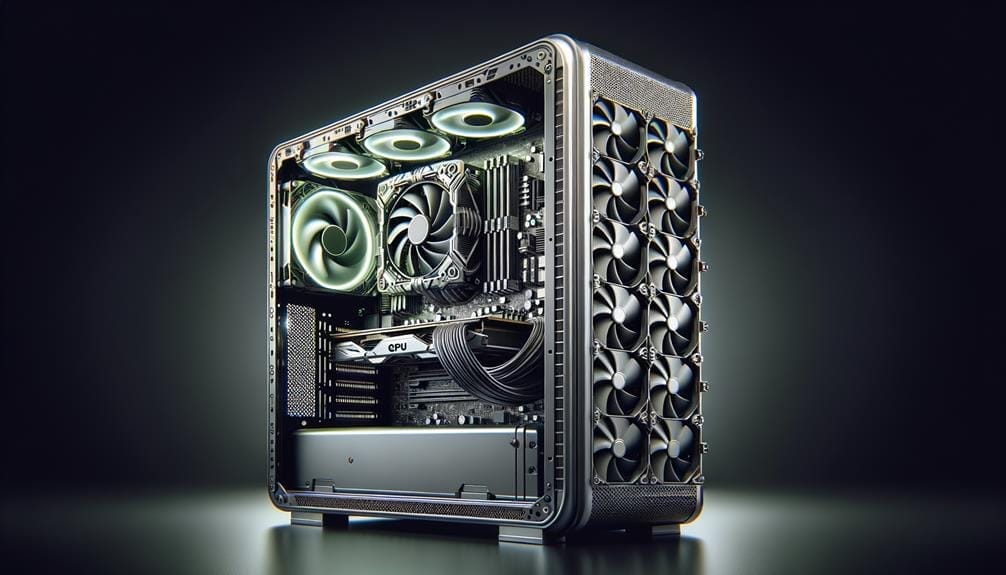
It’s incredibly annoying when the powerful graphics processors (GPUs) in your computer aren’t working to their full potential due to troublesome issues hidden in your system’s settings. Yet, running into these problems happens more often than you’d think. The silver lining? You possess the power to resolve these issues and get your GPUs back to operating at maximum efficiency.
By delving into the intricacies of multi-GPU configurations and understanding the factors that can hinder their performance, you'll be equipped to optimize your setup for peak efficiency.
From identifying bottlenecking factors to practical considerations for maximizing GPU performance, this discussion will provide you with valuable insights to ensure that your GPUs operate at their full potential, regardless of the demanding tasks you use them for.
Key Takeaways
- Multi-GPU setups in PCs require a compatible motherboard and high-end consumer or HEDT CPU for optimal performance.
- GPU bottlenecking can occur due to limited PCI Express bandwidth, slow storage, slow CPU, or insufficient RAM.
- The number of GPUs without bottlenecking depends on the available PCI Express lanes and motherboard support.
- Multi-GPU setups are not recommended for gaming due to limited support and lack of proportional performance boost, but they work well for professional rendering and editing PCs.
Understanding Multi-GPU Setups
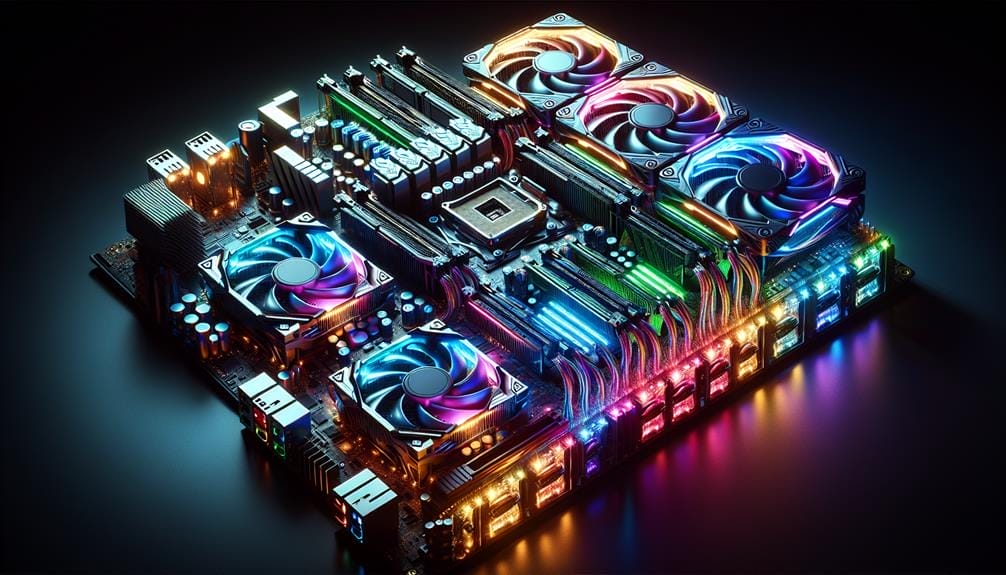
To grasp the intricacies of multi-GPU setups, it's essential to understand the underlying principles and potential challenges they present.
The advantages of multi-GPU configurations include enhanced graphics performance for gaming and accelerated rendering for professional workloads.
Best practices for multi-GPU setups involve using compatible motherboards with multiple full-speed PCIe x16 slots to avoid bottlenecking.
When setting up multi-GPU configurations, ensure that the GPUs can be connected with a physical bridge for improved performance.
Additionally, prioritize high-end consumer CPUs or HEDT CPUs to handle different workloads effectively.
It's crucial to consider the number of GPUs without bottlenecking, as this depends on the available PCI Express lanes and motherboard support.
In gaming, prioritize single GPU builds, while in editing and rendering, multi-GPU setups can significantly boost performance when supported by the software or engine.
Identifying GPU Bottlenecking Factors
Understanding multi-GPU setups allows you to identify the factors that can potentially bottleneck GPU performance. Overcoming PCI limitations and optimizing storage speed are crucial in maximizing GPU efficiency. Limited PCI Express bandwidth can throttle GPU performance, while slow storage can hinder a GPU's ability to render and process large files. By ensuring that your system adequately supports the GPU setup and that storage speed is optimal, you can mitigate potential bottlenecks. Below is a table summarizing key factors that can impact GPU performance:
| Bottlenecking Factor | Description | Mitigation |
|---|---|---|
| PCI Express Limits | Insufficient bandwidth for GPU usage | Use HEDT platforms for more PCIe lanes |
| Storage Speed | Slower storage impacts file processing | Upgrade to NVMe storage for faster data access |
Determining Optimal Number of GPUs
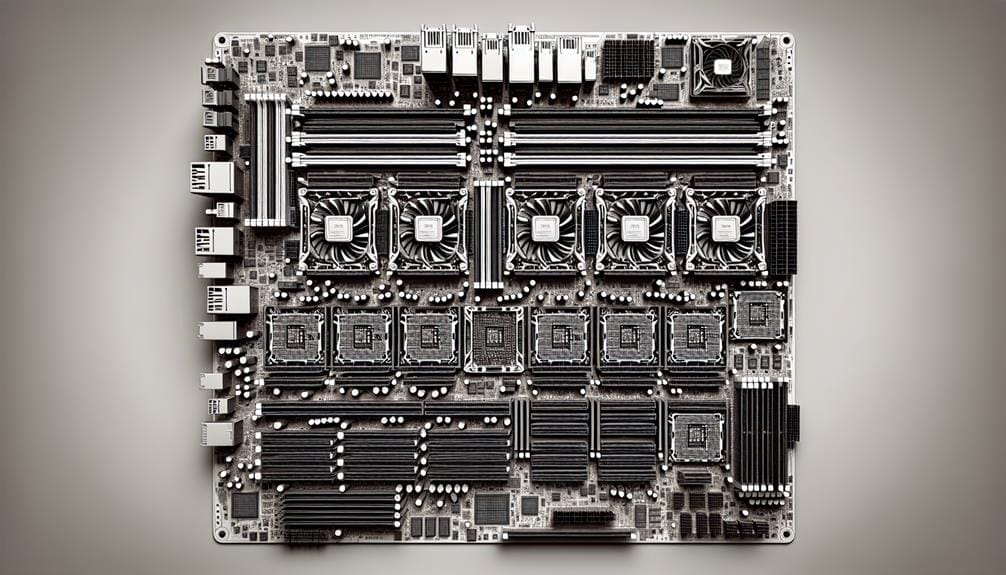
When considering the optimal number of GPUs for your PC, it's essential to evaluate the available PCI Express lanes and motherboard support.
Here's what you should consider:
- Available PCI Express Lanes:
- Determine the number of available PCIe lanes on your motherboard
- Ensure that each GPU has enough lanes for optimal performance
- Consider the impact of other PCIe devices on the total available lanes
- Motherboard Support:
- Check if the motherboard supports multiple GPUs without throttling
- Look for high-quality power delivery to support multiple GPUs effectively
- Consider the impact of managing power consumption when adding multiple GPUs
Maximizing GPU utilization and managing power consumption are crucial factors in determining the optimal number of GPUs for your PC.
Multi-GPU Setups in Gaming
Considering gaming performance, multi-GPU setups are generally not recommended due to limited developer support and the lack of proportional performance gains. Challenges in implementing multi-GPU setups for gaming include compatibility issues, micro-stuttering, and driver optimization. Here's a comparison of the challenges and performance factors of multi-GPU setups in gaming:
| Challenges | Performance Factors | Impact |
|---|---|---|
| Compatibility issues | Limited game support | Reduced performance |
| Micro-stuttering | High resolutions and frame rates | Inconsistency in rendering |
| Driver optimization | GPU driver updates | Unpredictable performance |
In gaming, the focus should be on optimizing a single powerful GPU rather than dealing with the complexities of multi-GPU configurations. This approach ensures better compatibility, stability, and overall gaming experience.
Multi-GPU Setups in Editing and Rendering
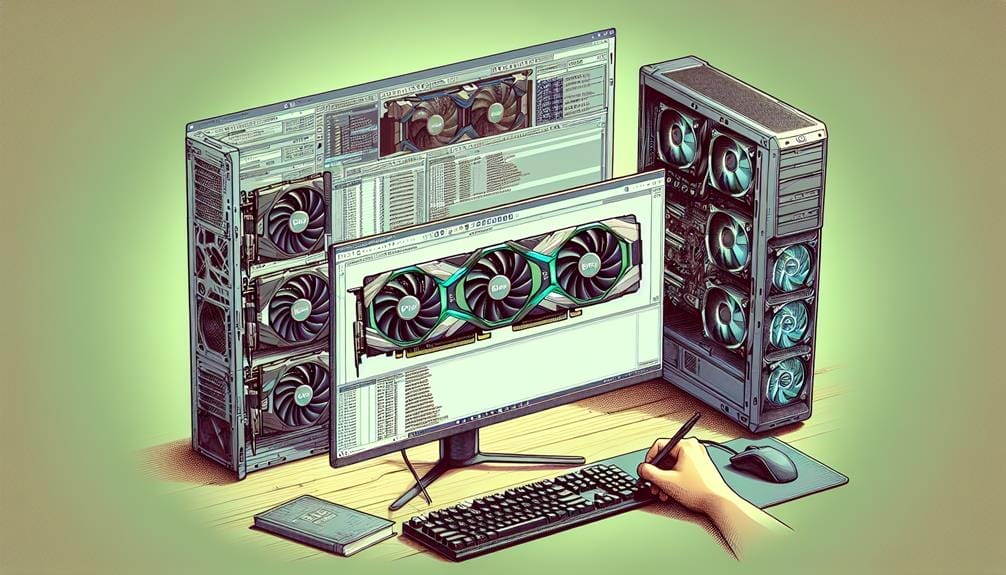
As you shift your focus from gaming to professional editing and rendering, the potential benefits of multi-GPU setups become more pronounced. When considering multi-GPU setups for editing and rendering, it's essential to understand the performance benefits and compatibility with professional software.
Multi GPU performance benefits:
- Enhanced rendering speeds and improved real-time editing capabilities
- Efficient handling of large and complex projects
- Accelerated processing of high-resolution video and 3D content
Compatibility with professional software:
- Support for multi-GPU acceleration in leading editing and rendering applications
- Seamless integration with industry-standard tools for optimal performance
- Reliable multi-GPU scaling for smooth and efficient workflow execution
Impact of Motherboard Support
To maximize the potential of multi-GPU setups, it's crucial to understand the impact of motherboard support on the overall performance and scalability of the system. Optimizing motherboard compatibility is essential for maximizing GPU performance. The table below outlines key factors to consider when evaluating motherboard support for multi-GPU setups:
| Factors to Consider | Description | Importance |
|---|---|---|
| Number of PCIe Slots | Determines the ability to install multiple GPUs | High |
| PCIe Lane Distribution | Ensures optimal distribution of bandwidth | Critical |
| SLI/CrossFire Compatibility | Enables seamless operation of multiple GPUs | Moderate |
Choosing a motherboard with ample PCIe slots, balanced lane distribution, and support for SLI/CrossFire can significantly impact the performance of multi-GPU setups. Prioritizing these factors will help avoid bottlenecks and unleash the full potential of your GPUs.
Overcoming GPU Bottlenecking
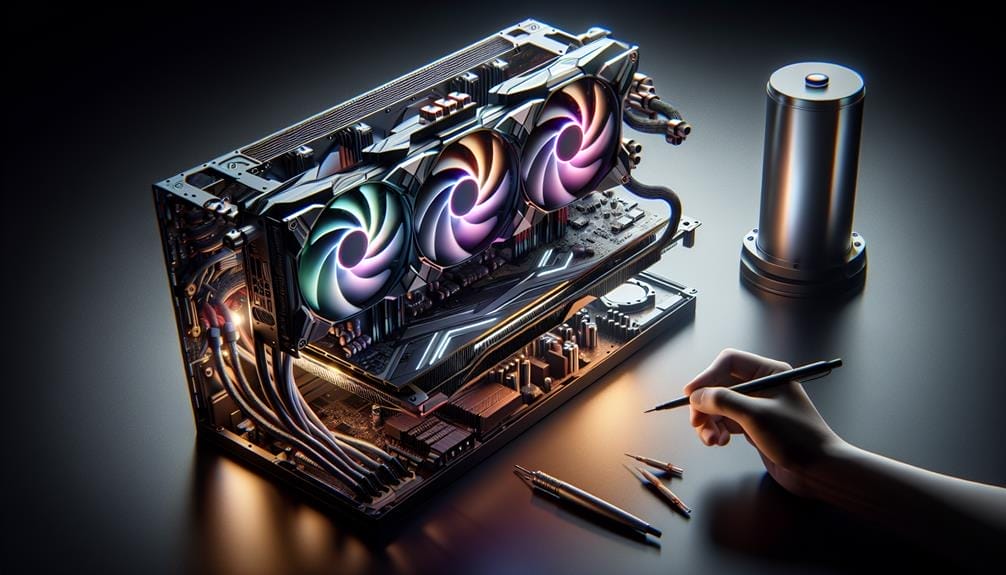
To optimize the performance of multi-GPU setups and address potential bottlenecks, prioritizing factors such as balanced lane distribution and ample PCIe slot availability on the motherboard is crucial. When overcoming GPU bottlenecking, consider the following:
- Overcoming PCIe Limitations:
- Utilize motherboards with optimal lane distribution to avoid PCIe bandwidth limitations.
- Consider high-end consumer or HEDT CPUs with sufficient PCIe lanes for multi-GPU setups.
- Explore GPU bridge technologies for efficient data transfer between GPUs.
- Optimizing GPU-CPU Interaction:
- Ensure compatibility between the GPU and CPU for seamless data exchange.
- Opt for CPUs with high clock speeds and core counts to support multi-GPU processing.
- Utilize optimized drivers and software to facilitate efficient communication between the GPU and CPU.
Maximizing GPU Performance in PCs
You can optimize GPU performance in your PC by ensuring proper hardware compatibility and configuration. Troubleshooting GPU bottlenecks involves checking for limited PCI Express bandwidth, slow storage, a slow CPU, and insufficient RAM.
To maximize GPU performance, ensure your motherboard supports multiple full-speed PCIe x16 slots for multi-GPU setups. High-end consumer or HEDT CPUs are essential for different workloads, especially in professional rendering PCs. Consider investing in HEDT platforms for 3D animation and rendering, as they offer more PCI Express lanes for multi-GPU setups.
For gaming-focused PCs, prioritize single GPU builds due to limited multi-GPU support in games. Keep in mind that multi-GPU setups work well for professional rendering, video editing, and compositing, with software or engine support influencing multi-GPU scaling.
Future-Proofing GPU Configurations
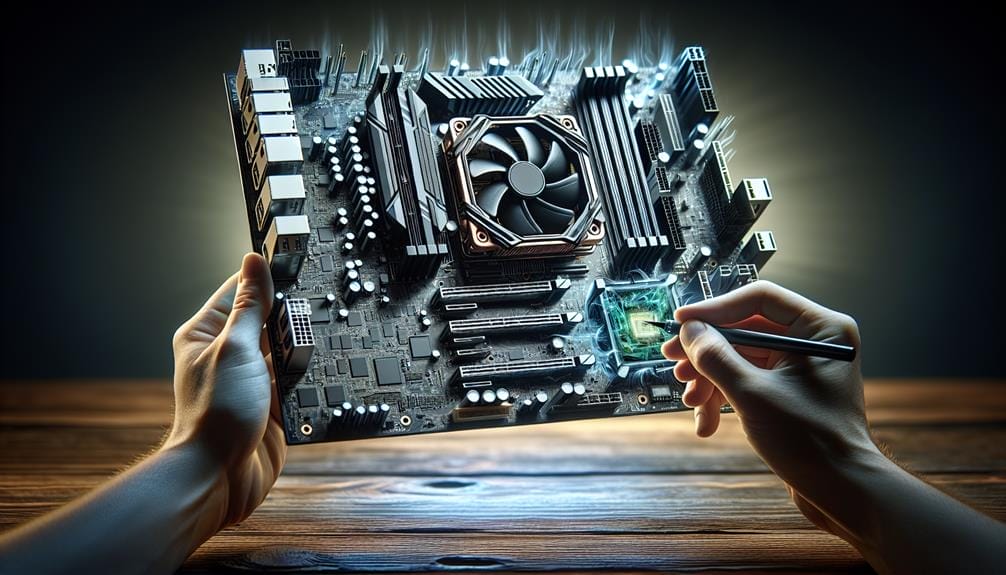
Maximizing GPU performance in your PC requires future-proofing your GPU configurations to ensure long-term compatibility and optimal performance.
- Invest in a high-quality motherboard
- Look for multiple full-speed PCIe x16 slots for future multi-GPU setups
- Ensure compatibility with upcoming GPU technologies
- Consider HEDT motherboards for more PCIe lanes and better multi-GPU support
- Choose a powerful CPU
- Opt for high-end consumer or HEDT CPUs to handle future GPU workloads
- Future-proof by selecting CPUs with ample PCIe lanes and high clock speeds
- Consider compatibility with upcoming GPU technologies for optimal performance
- Upgrade to sufficient power supply
- Ensure the power supply can accommodate additional GPUs in the future
- Consider potential power requirements of future GPUs
- Future-proof by investing in a high-quality, high-wattage power supply to support multiple GPUs
Practical Considerations for Multi-GPU Setups
Practical considerations for setting up multiple GPUs in your PC include assessing your motherboard's support for full-speed PCIe slots and evaluating the potential impact on overall system performance. When setting up multi-GPU configurations, it's important to consider the impact on power consumption and the potential for common issues that may arise, such as driver conflicts and compatibility problems. Troubleshooting these common issues is essential for ensuring a smooth multi-GPU setup. Additionally, be mindful of the increased power draw associated with multiple GPUs, as it may necessitate a higher wattage power supply to accommodate the additional load. Below is a table summarizing the impact of multi-GPU setups on power consumption and common issues to troubleshoot:
| Impact on Power Consumption | Common Issues in Multi-GPU Configurations |
|---|---|
| Increased power draw | Driver conflicts |
| Higher wattage PSU required | Compatibility problems |
Conclusion
So, now that you understand the key considerations for setting up and optimizing multiple GPUs in your PC, you can take the necessary steps to ensure that your GPUs operate at their full potential.
By avoiding bottlenecks and understanding the impact of limited PCI Express bandwidth, you can maximize the performance of your multi-GPU configuration for gaming, editing, rendering, and other demanding tasks.
Get ready to elevate your computing experience to new heights with your optimized GPU setup.

